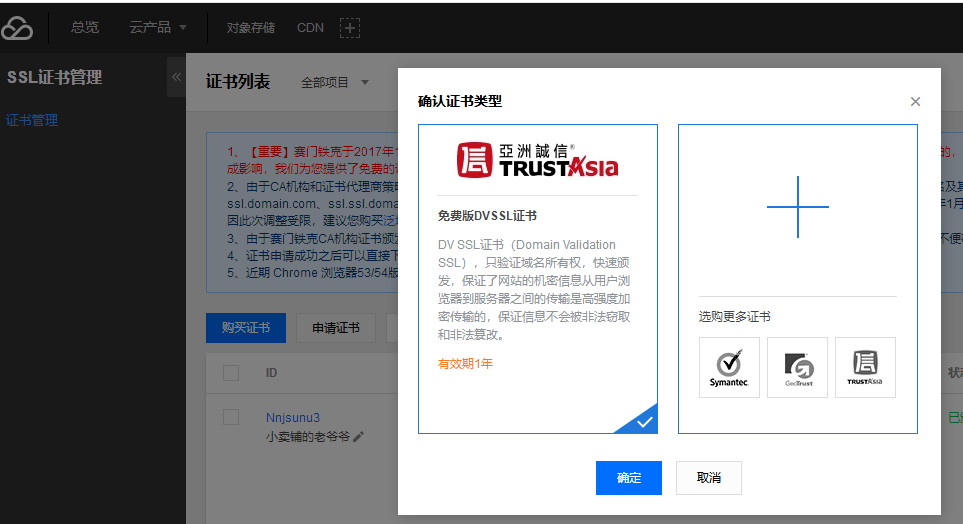記一次全站升級https引發的一系列問題
中秋假期,閒來無事。花了一下午折騰了下https,說實話這年頭還有網站不上https顯然是折騰精神不夠啊~
1、SSL證書評估
看了市面上各種型別的證書,有收費的也有免費的,但是最終還是選擇了騰訊雲提供的TrustAsia一年免費期的證書,沒有次數限制,可以過期後再次申請。最主要的原因還是我懶,哈哈~~

2、SSL證書安裝
從騰訊雲將申請的證書下載到本地,解壓獲得3個資料夾,分別是Apache、IIS、Nginx 伺服器的證書檔案,可以根據自己的實際情況,安裝在三種伺服器上。
我這裡使用Nginx做前端轉發。更多的介紹可以檢視文件:https://cloud.tencent.com/document/product/400/4143
2.1 獲取證書
Nginx資料夾內獲得SSL證書檔案 1_www.domain.com_bundle.crt 和私鑰檔案 2_www.domain.com.key,1_www.domain.com_bundle.crt 檔案包括兩段證書程式碼 “-----BEGIN CERTIFICATE-----”和“-----END CERTIFICATE-----”,2_www.domain.com.key 檔案包括一段私鑰程式碼“-----BEGIN RSA PRIVATE KEY-----”和“-----END RSA PRIVATE KEY-----”。
2.2 證書安裝
將域名 www.domain.com 的證書檔案1_www.domain.com_bundle.crt 、私鑰檔案2_www.domain.com.key儲存到同一個目錄,例如/usr/local/nginx/conf目錄下。更新Nginx根目錄下 conf/nginx.conf 檔案如下:
server { listen 443; server_name www.domain.com; #填寫繫結證書的域名 ssl on; ssl_certificate 1_www.domain.com_bundle.crt; ssl_certificate_key 2_www.domain.com.key; ssl_session_timeout 5m; ssl_protocols TLSv1 TLSv1.1 TLSv1.2; #按照這個協議配置 ssl_ciphers ECDHE-RSA-AES128-GCM-SHA256:HIGH:!aNULL:!MD5:!RC4:!DHE;#按照這個套件配置 ssl_prefer_server_ciphers on; location / { root html; #站點目錄 index index.html index.htm; } }
配置完成後,先用bin/nginx –t來測試下配置是否有誤,正確無誤的話,重啟nginx。就可以使用 https://www.domain.com 來訪問了。
注:
| 配置檔案引數 | 說明 |
|---|---|
| listen 443 | SSL訪問埠號為443 |
| ssl on | 啟用SSL功能 |
| ssl_certificate | 證書檔案 |
| ssl_certificate_key | 私鑰檔案 |
| ssl_protocols | 使用的協議 |
| ssl_ciphers | 配置加密套件,寫法遵循openssl標準 |
2.3 使用全站加密,http自動跳轉https(可選)
對於使用者不知道網站可以進行https訪問的情況下,讓伺服器自動把http的請求重定向到https。在伺服器這邊的話配置的話,可以在頁面里加js指令碼,也可以在後端程式裡寫重定向,當然也可以在web伺服器來實現跳轉。Nginx是支援rewrite的(只要在編譯的時候沒有去掉pcre)在http的server裡增加rewrite ^(.*) https://$host$1 permanent;這樣就可以實現80進來的請求,重定向為https了。
3、證書安裝的一系列問題。
3.1 埠號問題
需要注意的是,我們通常使用的80埠作為http預設訪問的埠,而在https中使用的443埠,這個是需要特別注意的,我在安裝過程中一開始就沒有注意埠號的問題,導致https一直沒有生效,後來問了公司的運維同學才知道,耽誤了很長的時間。
3.2 http跳轉https
一般我們的網站支援https之後,就不在支援http的訪問了。這時候就需要把http的訪問請求,重定向到https。實現的過程也很簡單,新增一個server,然後加入以下配置。
server {
listen 80;
location / {
rewrite (.*) https://www.laoyeye.net;
}
}
直接將80埠的訪問,全部轉發到網站的https域名,其實我這個寫的還不是很規範,一般不會將域名寫死,而是根據請求的域名做重定向的。
3.3 一級域名跳轉二級域名的問題
一般我們的網站很多都想讓www作為網站的首頁,這是一個二級域名,而我們預設的一級域名,如laoyeye.net是不提供服務的,這個時候就需要將https訪問這個域名的請求重定向到www域名,實現的過程也很簡單。
server {
listen 443;
server_name laoyeye.net; #填寫繫結證書的域名
ssl on;
ssl_certificate 1_www.laoyeye.net_bundle.crt;
ssl_certificate_key 2_www.laoyeye.net.key;
ssl_session_timeout 5m;
ssl_protocols TLSv1 TLSv1.1 TLSv1.2; #按照這個協議配置
ssl_ciphers ECDHE-RSA-AES128-GCM-SHA256:HIGH:!aNULL:!MD5:!RC4:!DHE;#按照這個套件配置
ssl_prefer_server_ciphers on;
location / {
rewrite (.*) http://www.laoyeye.net;
}
}
這裡需要注意http://laoyeye.net的域名,在上面埠80的監聽中已經做了處理的。這裡只是處理https://laoyeye.net的域名哦。
3.4 400 Bad Request | The plain HTTP request was sent to HTTPS port

完成上述的配置,基本上訪問http://www.laoyeye.net/,還是http://laoyeye.net/,亦或是https://laoyeye.net/,均會跳轉到https://www.laoyeye.net/。但是我發現個別的連結訪問會出現400錯誤,搞了一下午才弄清問題所在。
原因主要是我在後端邏輯處理的時候使用了重定向,後端重定向後返回的是http連結,就會出現這個問題。
解決辦法也很多,很多人會改tomcat的配置,讓重定向後的連結直接是https形式的。其實我不怎麼喜歡這種方式,因為這樣做的侵入性太大。當換一個tomcat伺服器後,可能你並不會想起這個配置。
既然我們是在nginx上配置的ssl,這裡我們還是從nginx上想辦法。
在location種加入如下配置
proxy_redirect http:// https://;
這句話的作用是對傳送給客戶端的URL進行修改, 將http協議強制轉為https,完成這個配置後就不會出現400的問題了。
當然我還有一些個人的配置問題,比如QQ互聯的回撥地址啦,也是需要修改http為https才能正常使用。
最後附個人nginx的配置供參考:
user root;
worker_processes 1;
#error_log logs/error.log;
#error_log logs/error.log notice;
#error_log logs/error.log info;
#pid logs/nginx.pid;
events {
worker_connections 1024;
}
http {
include mime.types;
default_type application/octet-stream;
upstream tomcat_server {
server xxxx:xxxx;
}
#log_format main '$remote_addr - $remote_user [$time_local] "$request" '
# '$status $body_bytes_sent "$http_referer" '
# '"$http_user_agent" "$http_x_forwarded_for"';
#access_log logs/access.log main;
sendfile on;
#tcp_nopush on;
#keepalive_timeout 0;
keepalive_timeout 65;
#gzip on;
server {
listen 80;
location / {
rewrite (.*) https://www.laoyeye.net;
}
}
server {
listen 443;
server_name laoyeye.net;
ssl on;
ssl_certificate 1_www.laoyeye.net_bundle.crt;
ssl_certificate_key 2_www.laoyeye.net.key;
ssl_session_timeout 5m;
ssl_protocols TLSv1 TLSv1.1 TLSv1.2;
ssl_ciphers ECDHE-RSA-AES128-GCM-SHA256:HIGH:!aNULL:!MD5:!RC4:!DHE;
ssl_prefer_server_ciphers on;
#charset koi8-r;
#access_log logs/host.access.log main;
location / {
rewrite (.*) https://www.laoyeye.net;
}
#error_page 404 /404.html;
# redirect server error pages to the static page /50x.html
#
error_page 500 502 503 504 /50x.html;
location = /50x.html {
root html;
}
# proxy the PHP scripts to Apache listening on 127.0.0.1:80
#
#location ~ \.php$ {
# proxy_pass http://127.0.0.1;
#}
# pass the PHP scripts to FastCGI server listening on 127.0.0.1:9000
#
#location ~ \.php$ {
# root html;
# fastcgi_pass 127.0.0.1:9000;
# fastcgi_index index.php;
# fastcgi_param SCRIPT_FILENAME /scripts$fastcgi_script_name;
# include fastcgi_params;
#}
# deny access to .htaccess files, if Apache's document root
# concurs with nginx's one
#
#location ~ /\.ht {
# deny all;
#}
}
server {
listen 443;
server_name www.laoyeye.net;
ssl on;
ssl_certificate 1_www.laoyeye.net_bundle.crt;
ssl_certificate_key 2_www.laoyeye.net.key;
ssl_session_timeout 5m;
ssl_protocols TLSv1 TLSv1.1 TLSv1.2;
ssl_ciphers ECDHE-RSA-AES128-GCM-SHA256:HIGH:!aNULL:!MD5:!RC4:!DHE;
ssl_prefer_server_ciphers on;
location / {
#域名www.laoyeye.net的請求全部轉發到tomcat_server即tomcat服務上
proxy_pass http://tomcat_server;
proxy_set_header Host $host:$server_port;
proxy_set_header X-Real-IP $remote_addr;
proxy_set_header X-Real-PORT $remote_port;
proxy_set_header X-Forwarded-For $proxy_add_x_forwarded_for;
# 必須配置:
proxy_set_header X-Forwarded-Proto $scheme;
# 作用是對傳送給客戶端的URL進行修改, 將http協議強制轉為https
proxy_redirect http:// https://;
index index.jsp index.html index.htm;
}
}
# another virtual host using mix of IP-, name-, and port-based configuration
#
#server {
# listen 8000;
# listen somename:8080;
# server_name somename alias another.alias;
# location / {
# root html;
# index index.html index.htm;
# }
#}
# HTTPS server
#
#server {
# listen 443 ssl;
# server_name localhost;
# ssl_certificate cert.pem;
# ssl_certificate_key cert.key;
# ssl_session_cache shared:SSL:1m;
# ssl_session_timeout 5m;
# ssl_ciphers HIGH:!aNULL:!MD5;
# ssl_prefer_server_ciphers on;
# location / {
# root html;
# index index.html index.htm;
# }
#}
}
